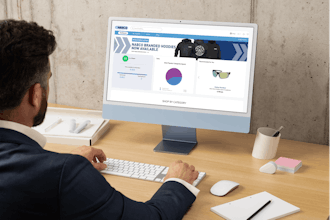
Since the onset of COVID, many companies invested heavily in building up their operational analytical capabilities as they struggled with disruptions to traditional approaches to data gathering, decision-making and communication. Distribution is becoming truly, if still inconsistently, data-driven.
Why should it be surprising that the industry is becoming data-driven? Because, simply put, distribution is a thin-margin business, where the average EBITDA as a percentage of sales is around 4% — small differences add up to a lot. High-performing distributors commonly achieve rates of return double or even triple that level, even controlling for market mix and sector. Elite distributors have a sharper understanding of the profit levers in their businesses, and they have tighter linkages from business insights to operational excellence. They put their data to work in the service of optimizing the profit levers that matter. The NAW CEO Roundtable companies, having a self-selection bias in favor of best-practices and continuous improvement, reflect this analytical transformation.
Modern Analytics to Optimize Outcome
Despite their impressive data-centricity, however, the vast majority of companies I talk to appear to be stuck in the entry-level state of Power BI, descriptive analytics: understanding what happened in the past. While it’s critical to understand where you’ve been to make sense of where you could or should go next, it’s not sufficient for scalable, operational excellence. A critical problem: most companies’ analytical capabilities remain stubbornly cloistered in the hands of a small number of power users (hence Power BI). Additionally, there’s little transfer of insights to the front-line employees (sales reps, purchasing managers, branch/operations managers) where the insights must be deployed to improve decision-making and business performance.
Moreover, another shortcoming inevitably arises. Usually, companies in the descriptive analytics stage aspire to attain the insights provided by predictive analytics: understanding, based on what happened in the past, what is likely to happen in the future. Of course, some of the infinite analytical outcomes that are likely to happen next are good, and others are bad. Unfortunately, even predictive analytics fail to answer the critical question, particularly at scale, as to what should happen next: what actions should be taken now to achieve the best possible outcome? For companies stuck in the descriptive or predictive stages of analytics, the most complex business dynamics trundle along on autopilot, because there is no flow of prescriptive analytics to guide daily actions at the street level.
Stare & Compare (& Guess)
For companies stuck in the first two levels, trying to answer the questions of What should I do next?, the usual approach is what I like to call “Stare & Compare.” Ask your resident power user to look at charts/trendlines, click on filters and drill-downs to contextualize data, and then make a guess at what would likely happen next and another guess at what to do next. Stare at the past, Compare the possible outcomes, Guess what to do next.
Spray and Pray
For enthusiastic data-centric companies who get stuck at the descriptive or predictive stages of analytics, they may start pumping out (emailing) spreadsheets and dashboards to their front-line employees to “improve business performance.” Unfortunately, many front-line employees (sellers, CSRs, operations employees) aren’t librarians at heart, so the data isn’t naturally actionable to them — or it gets stuck in unopened emails.
To make matters worse, the analytics lack prioritization, overwhelming recipients with too many possible data points to evaluate, let alone act upon and convert to business impact. Here, the insights are being democratized to front-line employees, which is good, but the immature analytical but the immature analytical stage precludes capturing the expected practical value. The theory: if we pump out lots of insights (Spray), some of them will convert to impact (we Pray). For obvious reasons, Spray and Pray fails to achieve the ROI that Power BI’s considerable efforts should require.
A Path Forward
To truly master data-centricity, companies must move beyond descriptive and predictive analytics to deploy prescriptive analytics. Prescriptive analytics guide front-line employees straight to the prioritized decisions and actions that will predictably improve business impact away from the historical past state to the optimized desired future state, answering key questions:
- Which customer should I call next? What should I talk about? How often should I call? Face-to-Face, or Zoom/Teams
- What products should a customer buy from me that they aren’t or are under-consuming?
- What price should I charge a given customer for a given product?
- What cost or rebate should I obtain from a vendor?
- What is the right service model for a given customer, quote or order?
Every distribution business has innumerable performance gaps, where actual values are well below optimal values. The key to closing these gaps is migrating beyond mere descriptive and predictive analytics to the modern capabilities of prescriptive analytics. Here, front-line employees don’t have to be librarians or spreadsheet jockeys to know what to do next.
Like a GPS system compared to an atlas, the insights are simplified, contextualized, and presented just-in-time in users’ daily workflow tools (ERP, CRM, LMS). The best tools will have a closed-loop system behind them, tracking assignment, execution and conversion of prescribed actions into desired outcomes. With advanced contributions of machine learning and AI, the closed-loop system continuously adapts and sharpens the recommendations, improving the employee experience and business impacts. The result: Six Sigma, continuous improvement, at scale.
Capture the Value of Analytics
Today, we live in a world where data is the new gold. But to truly capture the value of analytics, distributors need to push beyond power BI tools into the world of prescriptive analytics and AI. Now, the elite will separate from (or acquire) the merely average.
Download this pricing buying guide to help you determine the best path to victory for your company. Pricing is the most valuable performance lever and how you choose to handle it greatly impacts your company.
David Bauders is the CEO of SPARXiQ.






















